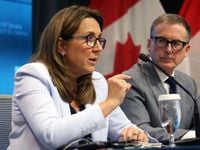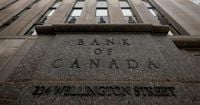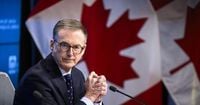The Bank of Canada held its interest rate steady at 2.75% on April 16, 2025, marking its first pause after a series of seven consecutive cuts that began in June 2024. This decision comes amid significant uncertainty stemming from U.S. trade policies, particularly those instituted by President Donald Trump, which have created volatility in global markets and raised concerns for Canadian businesses and households.
Governor Tiff Macklem, addressing the media in Ottawa, stated, “At this meeting, we decided to hold our policy rate unchanged as we gain more information about both the path forward for U.S. tariffs and their impacts. Faced with pervasive uncertainty, the Governing Council will proceed carefully, with particular attention to the risks.”
Trump's trade actions, including tariffs on steel, aluminum, and various goods not compliant with the Canada-United States-Mexico Agreement (CUSMA), have left Canadian exports vulnerable. On April 2, Trump announced tariffs on multiple countries worldwide, followed by a 90-day pause on April 9, during which a 10% baseline tariff on most countries remains in effect. Fortunately for Canada, it is not subject to this specific tariff.
In light of the ongoing unpredictability, the Bank of Canada opted not to provide a traditional economic forecast. Instead, it presented two potential scenarios in its monetary policy report to illustrate the possible impacts of the current trade environment on the Canadian economy.
In the first scenario, the bank assumes that most tariffs will be negotiated away, leading to a stalling of Canada’s GDP in the second quarter of 2025. Exports would sharply decline, and business investment would contract. Domestic demand is expected to remain weak, with modest quarterly consumption growth in 2025 before gradually strengthening in the following years. The removal of the federal consumer carbon price is projected to lower energy prices starting in April, reducing the Consumer Price Index (CPI) inflation by 0.7 percentage points for one year and bringing the average inflation for the year down to 1.5%.
Conversely, the second scenario predicts a prolonged global trade war, with several tariffs remaining in place permanently. This outcome could result in a significant contraction of Canada’s economy over the next year, with growth averaging -1.2% across four quarters before gradually recovering to around 1.8% in 2027. Inflation is expected to average close to 2% through the first quarter of 2026, spiking to 3% in the second quarter before returning to 2% in 2027. This scenario also foresees a marked decline in business investment and an increase in unemployment, as Canadian exporters reduce production and lay off workers.
Macklem emphasized that these scenarios are just two possibilities among many and do not encompass all potential outcomes. He noted, “To be clear, these are only two of many possible scenarios, and even these do not span the possible outcomes.” The recent announcements from the U.S. have shifted expectations, with the April 2 announcement leaning closer to Scenario 2, while the partial rollback on April 9 has nudged trade policy back towards a middle ground.
The Canadian economy ended 2024 on a strong note, but the uncertainty surrounding trade is already impacting growth this year. The Bank of Canada estimates that growth slowed to 1.8% in the first quarter of 2025, with consumption growth dropping from 5.5% in the previous quarter to just 1.5% in the first quarter of this year. Business investment is also expected to have declined by 2%, reflecting findings from the bank’s recent business outlook survey, which indicated that many firms are holding back on strategic new investments due to the trade situation.
Macklem reiterated the limitations of monetary policy in countering the impacts of a trade war, stating, “Monetary policy will ensure inflation remains well controlled and support economic growth as Canada confronts this unwanted trade war.” He also emphasized that the central bank would continue to monitor not only the uncertainty associated with the tariffs but also how businesses, households, and governments respond to them.
The decision to pause interest rate cuts has left many economists divided. While some viewed the hold as a necessary step given the current economic climate, others were leaning towards a quarter-point cut as a precaution against escalating U.S. tariff risks. Economists from RBC noted that the decision would be a close call for policymakers, especially given the weak employment data from March, which showed a job loss of 33,000 and an increase in the unemployment rate to 6.7%.
As the Bank of Canada navigates these turbulent waters, it has signaled its readiness to act decisively should the economic landscape deteriorate further. The next interest rate decision is scheduled for June 4, 2025, and markets are closely watching for any signs of change.
In summary, while the Bank of Canada has opted to maintain its current interest rate, the uncertainty surrounding U.S. trade policies continues to loom large over the Canadian economy. The central bank’s cautious approach reflects the delicate balance it must strike between supporting growth and controlling inflation in a rapidly changing global environment.








